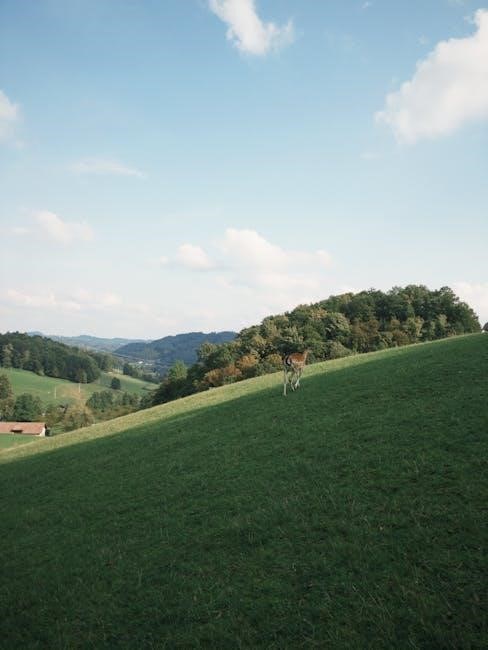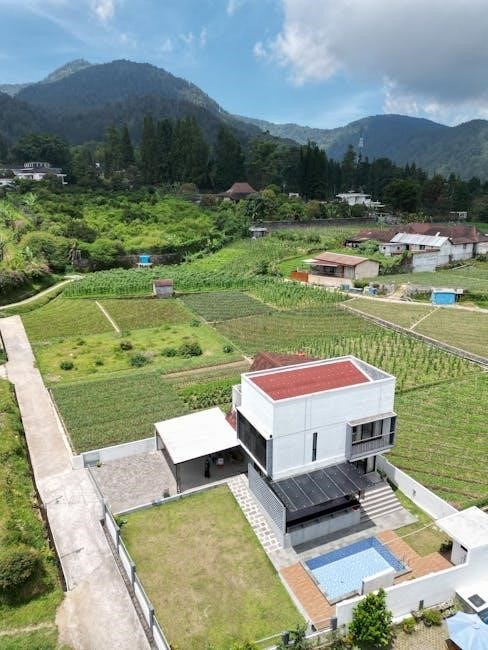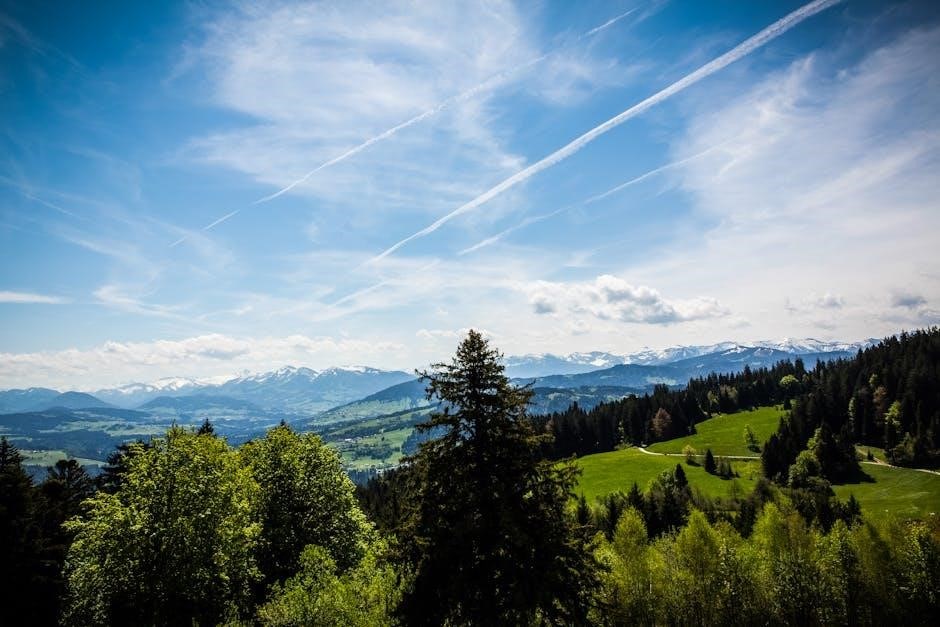Embark on a journey through Stardew Valley’s first year with this comprehensive guide. Master farming, relationships, and community goals to build a thriving farm and unlock new opportunities.
Understanding the Importance of Year 1 in Stardew Valley
Year 1 in Stardew Valley lays the foundation for your farming journey. It introduces you to the game’s core mechanics, such as planting seasonal crops, upgrading tools, and completing community center bundles. Each season—Spring, Summer, Fall, and Winter—lasts 28 days, offering unique opportunities to grow specific crops and engage in activities like fishing, mining, and socializing. New players often find Year 1 overwhelming due to the numerous tasks and limited resources. However, a strategic approach ensures progress, allowing you to complete the community center, build relationships, and prepare for future years. Proper planning helps maximize efficiency, whether it’s managing your daily routine or prioritizing skill upgrades. By focusing on key objectives, you can transform your farm into a thriving enterprise and set yourself up for long-term success in Stardew Valley.
Structure of the Day-by-Day Guide
This guide is divided into four seasonal sections, each spanning 28 days, to help you navigate Year 1 in Stardew Valley effectively. Starting with Spring, the guide breaks down daily objectives, such as planting parsnips, upgrading tools, and interacting with villagers. Summer focuses on high-value crops, fishing, and socializing, while Fall emphasizes foraging, crafting, and final community center progress. Winter concentrates on mining, fishing, and preparing for the next year. Each section provides a clear schedule, tips, and explanations to optimize your farm, skills, and relationships. The guide is flexible, catering to various play styles, and offers suggestions rather than rigid instructions. By following this structure, you can maximize efficiency, avoid overwhelm, and build a strong foundation for future years. Whether you’re a new player or seeking to improve, this guide ensures a balanced and rewarding experience in Stardew Valley.
Essential Tips for New Players
Starting your journey in Stardew Valley can feel overwhelming, but with the right strategies, you’ll thrive. Begin by prioritizing your first day: collect free parsnip seeds, plant them, and water them. Focus on upgrading your tools early, as this improves efficiency. Don’t neglect the community center—complete bundles to unlock rewards and progress. Learn to manage your time wisely, balancing farming, socializing, and exploration. Fishing and mining are excellent ways to earn extra gold and resources. Forage for wild items like berries and mushrooms to boost your health and energy. Use sprinklers as soon as possible to save time on watering crops. Lastly, explore multiple skills but focus on one or two at a time to avoid spreading yourself too thin. These tips will help you build a strong foundation and enjoy a smooth start to your Stardew Valley adventure.

Spring
Spring is the starting point of your Stardew Valley journey. It’s the perfect time to plant your first crops, interact with villagers, and lay the foundation for a thriving farm.
Day 1: Getting Started

Welcome to Stardew Valley! On your first day, you’ll arrive at your farm, which is in disrepair. Start by clearing debris like rocks and logs to create space for planting. Open your mailbox to receive parsnip seeds, your first crop. Plant them in tilled soil and water them. Familiarize yourself with your tools: the hoe for tilling, the watering can, and the pickaxe for mining. Energy management is key, so prioritize tasks and rest when needed. Visit Pierre’s shop to buy essential items. Introduce yourself to villagers to build relationships. Focus on clearing land and planting seeds to establish a foundation for your farm. This day sets the stage for your journey, so take it step by step and enjoy the beginnings of your new life in Stardew Valley.
Day 2-7: Planting and Watering
Days 2-7 are crucial for establishing your farm’s foundation. Focus on watering your parsnip seeds daily to ensure they grow properly. As your energy allows, continue clearing debris to create more space for future crops. By Day 3 or 4, your parsnips will be ready to harvest, providing your first income. Reinvest this gold into additional seeds, such as potatoes or carrots, which have quick turnaround times. Watering remains a priority, so check your crops daily to prevent wilting. Use this period to familiarize yourself with your farm’s layout and plan future expansions. Keep managing your energy levels to avoid exhaustion, as consistent progress is key during these early days. By Day 7, you should have a small but thriving crop rotation, setting you up for long-term success in Stardew Valley.
Day 8-14: Harvesting and Upgrading
Days 8-14 mark a pivotal phase where you’ll start reaping the rewards of your hard work. By now, your parsnips should be ready for harvest, providing a steady income. Use this gold to upgrade your tools, such as the watering can or hoe, to improve efficiency. Focus on maintaining your crops, ensuring they’re watered daily, and clear any remaining debris to expand your farm; Consider planting more parsnips or other quick-growing crops like potatoes to maximize your early-game profits. Energy management remains crucial, so prioritize tasks that offer the best returns. This period is also ideal for exploring the Community Center and understanding its requirements. By Day 14, you should have a small but thriving farm, setting the stage for future growth and development in Stardew Valley.
Day 15-28: Community Center Progress
Days 15-28 are crucial for advancing in the Community Center. Focus on completing bundles for the various rooms, such as the River Fish Bundle or the Vegetable Bundle. Plant high-value crops like strawberries and melons, as they can be used in bundles or sold for profit. Spend time fishing in the river or mining in the caves to gather necessary items. Prioritize upgrading your tools to improve efficiency. Engage with villagers by giving them loved items to increase friendship levels, which can unlock new heart events and rewards. By Day 28, aim to complete at least one room in the Community Center to earn rewards and unlock new areas. This period sets the foundation for long-term progress, so balance farming, socializing, and resource gathering to stay on track.
Summer

Summer brings warmth and new opportunities. Focus on planting high-value crops like corn and sunflowers. Fishing becomes more rewarding, and socializing with villagers intensifies. Explore the beach for unique items and upgrade tools to enhance efficiency. This season is ideal for advancing your farm and relationships, setting a strong foundation for the rest of the year.
Day 1: Transitioning to Summer
On the first day of Summer, prioritize harvesting any remaining Spring crops to clear space for new plantings. Check your farm for expired or leftover crops and clear debris to prepare for Summer planting. Restock seeds and fertilizers from Pierre’s shop, focusing on high-value Summer crops like corn and sunflowers. Review your Community Center progress to identify any missing items you can collect during the Summer season. Fishing becomes more lucrative in Summer, so ensure your fishing gear is in good condition and restock bait and tackle. Additionally, take time to socialize with villagers, as Summer events and heart quests often unlock during this season. Finally, manage your energy and gold wisely, as Summer offers numerous activities to balance.
Day 2-7: Planting Summer Crops
Dedicating the first week of Summer to planting high-value crops is essential. Focus on crops like corn, sunflowers, and melons, which mature quickly and yield significant profits. Ensure proper spacing and layout to maximize your farm’s productivity. Water your crops daily, especially during the first few days, to establish strong growth. Consider using fertilizers to boost crop quality and speed up maturation. Keep an eye on your energy levels, as planting and watering can be exhausting. Rotate your tasks to maintain a balance between farming and other activities like fishing or socializing. By the end of Day 7, your Summer crops should be well-established, setting you up for a profitable season. Regularly check the TV for Community Center bundle updates to align your planting strategy with completion goals.
Day 8-14: Fishing and Socializing
Days 8-14 of Summer are ideal for balancing fishing and socializing. Focus on fishing in the morning or late afternoon, as these are prime times to catch high-quality fish. The beach and river offer excellent spots for species like carp, sunfish, and shrimp. Use bait or tackle to increase your chances of rare catches. Socializing becomes crucial during this period—spend time with villagers, give them their favorite gifts, and engage in meaningful conversations. Building relationships can unlock heart events and valuable rewards. Check the community center bundles to see if any items you’ve caught or crafted can help complete them. Crafting crab cages during this time can also provide a steady source of income. By the end of Day 14, aim to have improved a few relationships and restocked your fishing supplies for the season ahead.

Day 15-28: Mid-Season Review
By Day 15, Summer is in full swing, and it’s time to evaluate your progress. Focus on harvesting your mature crops, such as strawberries and parsnips, and reinvest profits into new seeds or upgrades. Fishing remains lucrative, especially near the beach or in the river during rainy days. Socializing should continue, as stronger relationships can unlock new quests or items. Check your community center progress and complete any remaining bundles with items you’ve gathered. Consider upgrading tools like the watering can or axe to improve efficiency. Explore the mines if you haven’t already, as ores and gems can be sold or crafted into valuable items. By Day 28, aim to have a balanced farm, steady income, and solid relationships. This mid-season review ensures you’re on track for a successful Summer and sets you up for the season’s final push.

Fall
Fall brings new crops like cranberries and pumpkins. Focus on foraging, crafting, and managing resources. Prioritize community center progress and prepare for the end of Year 1.
Day 1: Preparing for Fall
Day 1 of Fall marks a fresh start. Begin by clearing your farm of any leftover debris, weeds, or unwanted crops. Use this opportunity to organize your space for the new season. Budget your gold wisely, as you’ll need seeds for Fall crops like cranberries, pumpkins, and grapes. Consider upgrading your tools if you haven’t already, as this will improve efficiency. Review your crop layout to ensure proper spacing and access. Take time to forage for wild items like blackberries and mushrooms, which are abundant in Fall. If you’ve restored the Greenhouse, now is a good time to plant high-value crops inside. Finally, check your community center progress and plan which bundles to complete next. Socialize with villagers to strengthen relationships and open up new quests. Keep your energy in check by prioritizing tasks and avoiding burnout. Preparing now sets you up for a successful Fall season.

Day 2-7: Planting Fall Crops
Days 2-7 of Fall are crucial for planting your primary crops. Focus on sowing high-value crops like cranberries, pumpkins, and grapes, as they yield significant profits. Ensure proper spacing and organization on your farm to maximize growth. Water your crops daily, especially during the early stages, to promote healthy development. Consider upgrading your watering can to improve efficiency. Plant scarecrows near your crops to protect them from crows. Use this period to till and fertilize any remaining plots for future planting. Keep an eye on your energy levels, as farming can be exhausting. Prioritize tasks like watering and harvesting over exploration during these days. By the end of this period, your Fall crops should be well-established, setting you up for a bountiful harvest later in the season.

Day 8-14: Foraging and Crafting
Days 8-14 of Fall are ideal for focusing on foraging and crafting. Explore the river and forest areas to collect seasonal resources like wild plums, blackberries, and mushrooms. These items are valuable for cooking, gifting, or selling. Use this time to craft essential tools or upgrades, such as a better pickaxe or ax, to enhance your farming and foraging efficiency. Consider crafting preserves or jams to preserve your Fall crops for future use. Foraging also provides opportunities to gather materials for community center bundles. Remember to balance your energy levels, as foraging and crafting can be energy-intensive. By the end of this period, you should have a solid stockpile of resources and crafted items to support your progress. This focus will help you stay prepared for the remainder of the season and beyond.
Day 15-28: Final Push for Community Center
Days 15-28 of Fall are crucial for completing the Community Center. Focus on gathering the last few items needed for the remaining bundles. Check your journal to identify missing items and prioritize crafting or acquiring them. Plant any Fall crops that can mature before the season ends, such as Ancient Fruits or Cranberries, to fulfill bundle requirements. Forage for Walnuts, Hazelnuts, and other seasonal items to complete bundles like the Vault or River Fish Bundle. Fishing in the river or pond can also yield essential items like Sunfish or Shad. Craft missing items using resources like cloth, minerals, or cooked dishes. Upgrade tools if needed to enhance efficiency. Manage your energy levels and focus on one or two bundles at a time to avoid burnout. By the end of Day 28, aim to complete all bundles and restore the Community Center, earning rewards and a sense of accomplishment.
Winter
Winter focuses on mining, fishing, and socializing. Plant Winter Roots, complete Community Center bundles, and engage with villagers to strengthen relationships and unlock new opportunities.
Day 1: Adapting to Winter
Winter arrives, bringing snow-covered fields and a new set of challenges. On Day 1, prioritize clearing debris from your farm to ensure it remains functional. Winter crops like Winter Roots can still be planted, but they require attention. Check your Greenhouse, as it becomes a vital resource for growing crops during the cold months. Focus on mining and fishing to gather resources, as these activities are more rewarding in Winter. Explore the Mines or Skull Cavern for ores and gems, and try fishing in icy waters for rare catches like Walleye or Perch. Socializing is key, as villagers may offer quests or unique interactions during this season. Finally, review your tools and upgrade them if necessary to improve efficiency in mining, fishing, and farming. This day sets the tone for a productive Winter season.

Day 2-7: Mining and Fishing
Dedicate these days to mining and fishing, as they are crucial for resource gathering during Winter. Start by exploring the Mines, focusing on clearing floors and collecting ores like Iron, Copper, and Coal. These resources are essential for crafting and upgrading tools. Use your pickaxe to break rocks and defeat monsters for additional loot. Consider upgrading your pickaxe to improve mining efficiency. For fishing, target Winter-specific fish like Walleye, Perch, and Tiger Trout, which can be found in icy waters. Fish near the waterfall or in the river for better catches. Experiment with bait and tackle to increase your success rate. These activities not only provide resources but also help build skills and generate income. Balancing mining and fishing ensures a steady supply of materials for crafting and tool upgrades.
Day 8-14: Managing Resources
During these days, focus on organizing and managing your resources effectively. Start by upgrading your chest storage to keep your items tidy and accessible. Prioritize crafting essential items like fences, torches, and bait to support your farming and fishing endeavors. Regularly check your inventory to ensure you have enough food, health-restoring items, and energy-boosting snacks. Use your crafting bench to turn excess materials into valuable tools or decorations. Don’t forget to cook meals that provide energy and health buffs, which are crucial for long days. Allocate time to repair or upgrade tools to maintain efficiency. By managing your resources wisely, you’ll optimize your progress and reduce waste, ensuring a smooth transition into the final weeks of the year.
Day 15-28: Year-End Preparation
As winter progresses, focus on finalizing your year-end tasks. Prioritize completing any remaining Community Center bundles to unlock rewards and achievements. Use this period to maximize your gold by selling high-value items like quality crops, fish, and crafted goods. Organize your farm by clearing unnecessary debris and ensuring all animals are happy and healthy. Upgrade your tools to their maximum levels to enhance efficiency in the next year. Strengthen relationships with villagers by giving them their favorite gifts and completing any remaining heart events. Prepare for the Feast of the Winter Star by crafting or purchasing gifts for the townspeople. Review your achievements and set goals for Year 2, ensuring you’re ready to tackle new challenges. Properly manage your resources, store items wisely, and plan for the upcoming season to ensure a strong start to Year 2.
Completing Year 1 in Stardew Valley is a milestone, showcasing your growth and dedication. Celebrate your accomplishments, reflect on lessons learned, and feel proud of the progress made. Use this momentum to prepare for the exciting challenges and opportunities that await in Year 2.
Year-End Review and Accomplishments
By the end of Year 1 in Stardew Valley, you should reflect on your journey and celebrate your achievements. If you followed the guide, you’ve likely established a thriving farm, strengthened relationships, and made significant progress on the Community Center. Take stock of your accomplishments, such as the number of crops harvested, animals raised, and friendships forged. Consider your income sources, like farming, mining, or fishing, and how they contributed to your success. Highlighting milestones, such as completing bundles or upgrading tools, will give you a sense of pride. This review helps identify areas for improvement and sets a foundation for Year 2. Remember, every accomplishment, no matter how small, is a step toward becoming a Stardew Valley master. Use this momentum to plan your next moves and continue building your farm and community ties.

Preparing for Year 2
As Year 1 comes to a close, it’s essential to prepare for the challenges and opportunities of Year 2. Start by organizing your farm, ensuring crops are planned and tools are upgraded. Restock fertilizers, seeds, and other supplies to maximize efficiency. Focus on upgrading your home and barn if possible, as this will accommodate more animals and provide better storage. Review your journal to identify unfinished Community Center bundles and prioritize them for early completion in Year 2. Strengthen relationships with villagers by giving them their favorite gifts before the year ends. Finally, allocate your gold wisely, investing in high-value crops or mining/fishing gear. A well-prepared farm and clear goals will set you up for success in the coming year, allowing you to tackle new challenges and achievements with confidence.




About the author